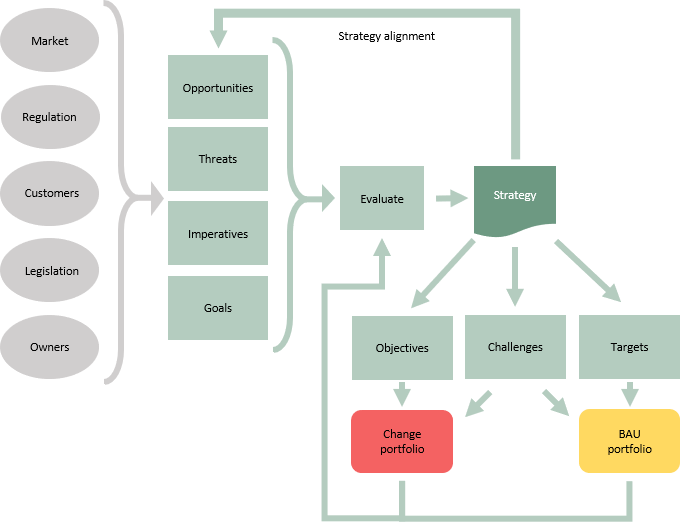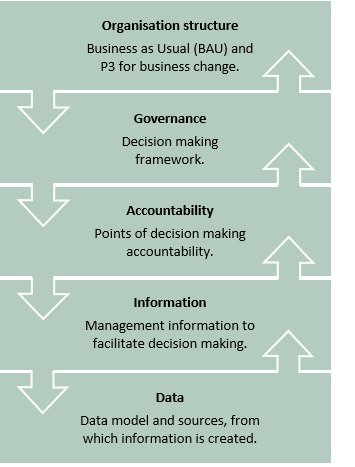The BIG model recognises that organisations have to deal with multiple issues. It classifies these ‘stimuli’ as Opportunities, Threats, Imperatives and Goals (OTIGs), which need to be evaluated in order to develop an effective strategy.
Real world examples of OTIGs and OTCs are described in the table at the bottom of this page.
Emerging from the strategy will be Objectives, Targets and Challenges (OTCs). In this model, objectives are expressed as outputs, outcomes or benefits to be achieved by projects and programmes in the change portfolio. Operational targets are delegated to operational teams and some of these may result in projects and programmes that collectively form the BAU portfolio.
Challenges may be allocated to either the change or BAU portfolios where they generate objectives or targets. Progress from the portfolios and BAU operations must provide feedback for further evaluation and refinement of the strategy.

Lapses in strategic alignment may result in significant strategy corrections instead of ongoing minor adjustments. This can mean that instead of just managing ‘ripples’ of change in the organisation there are more ‘waves’ to deal with.
Whether dealing with ripples or waves, a significant leadership challenge is to transmit OTCs through the organisation structure to accountable people who can provide the focal point for decision making.
The purpose of the BIG model is to provide a governance approach that facilitates the successful achievement of these strategic responses. In order to do that, it comprises five levels.
 Organisation Structure: The top level of the model deals with the organisation structure, which forms the foundation for governance. A clear organisation structure is needed to enable the mapping of OTCs to accountable points within the organisation. The lack of a clear structure and defined accountabilities reduces the possibility of truly integrated governance.
Organisation Structure: The top level of the model deals with the organisation structure, which forms the foundation for governance. A clear organisation structure is needed to enable the mapping of OTCs to accountable points within the organisation. The lack of a clear structure and defined accountabilities reduces the possibility of truly integrated governance.
Governance: There are many elements to governance and a good governance framework describes how and where decisions are made and by whom.
This level of the model provides a map of how the components in the framework can be inter-related – a picture that needs adapting for each organisation.
Accountability: Within the BIG model, decision points are referred to as Governance Nodes and several sample nodes are described at this level. It focuses on portfolios, programmes and projects but it is impossible to operate P3M governance without collaboration with BAU Governance Nodes, so these are also described but from the P3M perspective.
Information: Being accountable requires appropriate and meaningful management information derived from accurate data. Instead of stipulating tools, the model focuses on information needs within all Governance Nodes and promotes data sharing rather than complex systems integrations.
Data: The core data model contains definitions, has an example data structure and a technology example showing typical data and MI. This section also offers useful discussion of what is involved in providing a common container for housing data.
Overall, the model provides a framework that clarifies organisational context and governance components. It recommends leveraging existing methods and IT investments wherever possible and promotes an approach to change that is ‘outcome focused’. Instead of having a system of locally defined tools that push up what they can – it provides an integrated ecosystem that pulls up what is needed.
OTIGs and OTCs - Examples
Stimulus | Description | Example |
|---|---|---|
Opportunity | A circumstance from which an organisation could benefit. | The exploitation in Europe of a new iPad accessory prototype that has done well in North America. |
Threat | A circumstance that could harm an organisation. | Aging hardware in a core data centre is diminishing redundancy and stability. |
Imperative | An external necessity imposed on the organisation. | Procurement systems must be replaced by the end of the year to meet new legal requirements. |
Goal | An organisational aspiration. | The CEO requires profitability in the Americas to be increased by 5% in order to attract new investment. |
| Response | Description | Example |
|---|---|---|
| Objective | A required new component or state of the organisation. | In response to the 'threat' above: Migrate core data handling to a cloud solution. |
| Target | A measurable future accomplishment for organisational BAU. | In response to the opportunity above: European sales revenue for the new iPad accessory should be £800k in the first year. |
| Challenge | An OTIG that has yet to be assessed as an objective or target. | In response to the goal above: Increased profitability in the Americas may be achieved through increased sales, reduced costs or a combination of both. Once assessed this goal may lead to ideas for specific objectives and targets. |
Thank you to the Core P3M Data Club for providing this page.





